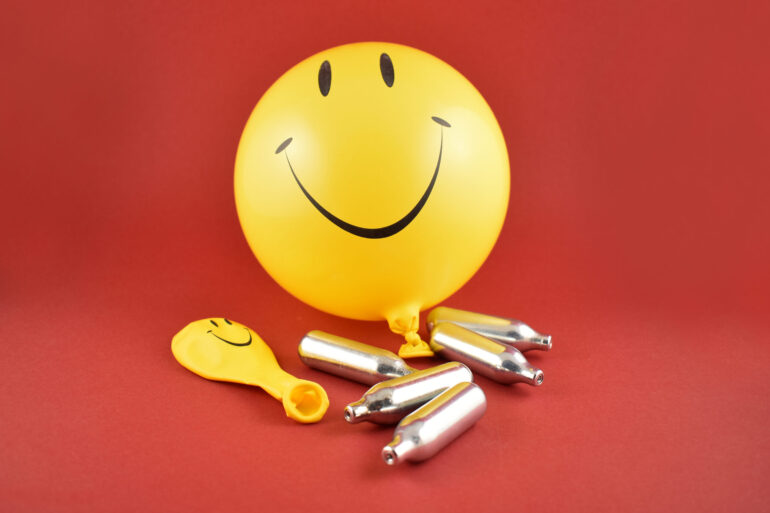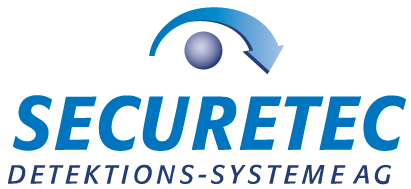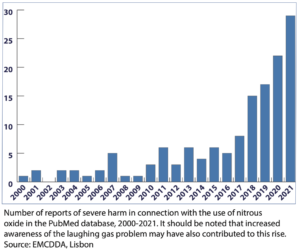
Laughing gas − no laughing matter?
15 poisoning incidents in all of 2015, compared with 67 in the first half of 2019 alone – these figures from the Netherlands are indicative of the rising misuse of laughing gas across Europe and in the United States. One study conducted by the University of Frankfurt in 2018 determined that consumption had doubled in just 3 years. And laughing gas is not only becoming an established party drug – it’s also being consumed on a daily basis by some users.
The buzz is short-lived – anything from 30 seconds to a few minutes. On the other hand, it’s both inexpensive and legal – as a result, laughing gas has made the leap to becoming a recognised recreational drug. The gas is consumed directly from whipped cream chargers or from balloons. The chargers/cannisters are available in bulk packs from discount stores, while filled balloons are available from street vendors or certain shops for no more than 5 euros apiece. Online sales of bulk packs are also booming.
Users report experiencing heightened sensory perception, euphoria and a tingling sensation throughout the entire body. Some people feel the urge to laugh and may speak with a squeaky “Mickey Mouse” voice. If an individual only consumes laughing gas as a one-off – for example, as a gag at a party – there are usually no negative outcomes. However, some users go much further than this. They may take up to 200 “hits” spread out over the course of a day or inhale the gas 100 times in rapid succession at a party. This is harmful to health and can even be fatal. In the Netherlands, where misuse is rife, police statistics recorded 63 accidental deaths due to the inhalation of laughing gas between the start of 2019 and October 2021.
The European Monitoring Centre for Drugs and Drug Addiction (EMCDDA) in Lisbon is tracking and documenting the growing consumption of laughing gas throughout Europe. The substance is not yet included in the German Drug and Addiction Report. However, based on the annual studies published by the University of Frankfurt, it can be assumed that laughing gas is playing an increasingly important role in Germany also. Up to 2021, there was a sharp rise in use among young consumers in particular. 2022 levels were marginally lower than the previous year. Current hotspots for laughing gas are the Netherlands, Britain and Denmark, while figures are also rising in France. In the United States, the New York Times has reported on the growing health problems caused by laughing gas. Despite this, banning the gas is problematic because it has many common uses in technology and medicine. In the Netherlands, it is expected that the ban recently introduced there (see box, left) will succeed in bringing street vendors and laughing gas cafés under control. The Dutch police can now also take action if they find private individuals in possession of bulk packs or large gas canisters. Efforts to put a similar ban in place have been made in Britain and Denmark.

The DrugWipe© product portfolio offers rapid screening drug tests to test saliva, surfaces and sweat – simply contact us, we’re always happy to help!
References:
European Monitoring Centre for Drugs and Drug Addiction EMCDDA, Lisbon, www.emcdda.europa.eu; Federal Centre for Health Education (Bundeszentrale für gesundheitliche Aufklärung, BZgA) Cologne, www.drugcom.de; Ministerie van Volksgezondheid, Welzijn en Sport vws, https://www.rijksoverheid.nl/ministeries/ministerie- van-volksgezondheid-welzijn-en-sport; Goethe University, Frankfurt a.M., https://www.uni-frankfurt.de/99133712/MoSyD_Jahresbericht_2019.pdf; Office of National Statistics. Drug misuse in England and Wales: year ending March, 2020, https://www.ons.gov.uk/peoplepopulationandcommunity/crimeandjustice/articles/d; Nitrous Nation. Hippie crack. Whippets. Laughing gas. A casual party drug, endures. The New York Times, 2021; January 31, https://www.nytimes.com/2021/01/30/style/nitrous-oxide- whippets-tony-hsieh.html




